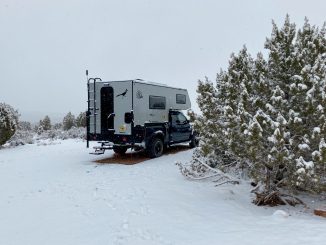
Winter truck camping can be one of life’s true pleasures. Few things provide more sensory delight than nestling deep into your sleeping bag against the morning’s chill. Things like the road conditions, the temperature, and the weather need to be considered. Of course, winter truck camping requires a bit more preparation than a summer weekend outing. Here’s what to know and carry.
What You Need
Your prep work for winter truck camping primarily revolves around deterring your biggest threat—the weather. Staying warm is the order of the day, although there are certainly other supplies you need, too. Here’s a basic list of what you need.
1. Staying Warm
Your first order of business is a subzero sleeping bag. A good general rule is to select a model rated for slightly colder conditions than you’re likely to encounter. Furthermore, give preference to models with zoned warmth areas—for example, extra lining near your feet.
You’ll also need various types of clothes, including for sleeping. The best sleeping clothes may also constitute your lightweight base layer, which should consist of a wicking fabric such as merino wool or a synthetic blend.
You don’t want to bundle up to sleep because your sleeping bag uses your body heat to keep you snug—going to bed fully dressed is essentially insulating yourself against your insulation. Stripping down inside your bag and pushing your clothes to your feet keeps them warm for wear the next day.
For heading out, apply basic dressing-in-layers rules:
- Your base layer, which consists of sweat-wicking fabric.
- Your middle layer, which insulates you. Think plenty of flannel and fleece. Some folks like to add a vest up top.
- Your outer layer protects you from the elements. It should be as wind and waterproof as possible.
Finally, remember your extremities. While it’s not true that you lose 50 percent of your heat through your head, you can lose around 10 percent, and gloves are necessary for protecting against frostbite. Keep a spare pair along with your extra underwear and socks in case they get wet.
Next, you’ll need at least two methods to generate external heat. A fire is one for many, but leaving it unattended while you sleep is risky. Let’s examine some alternatives:
- Some hybrid vehicles allow you to operate the onboard climate control without running the engine. This method is easiest, but beware that it may drain your battery if you are far from a power source.
- Portable 12-volt space heaters plug into your truck’s or camper’s 12 volt receptacle.
- A small solar generator and power bank are often sufficient to run a space heater at night, charging up during the day. However, you could run into trouble in severe cloudy conditions, especially with limited daytime hours.
- Portable propane heaters will keep you plenty warm, but toxic fumes can quickly accumulate in small spaces. They’re best saved for emergencies, and you must ensure you have adequate ventilation.
You always want at least two methods of making a fire when camping. Master a fireproof method, like a flint and steel, but carry the trusty—and easier to use—matches and lighters, as well.
The scenario you want to avoid is getting trapped in the cold with no means of escape. If you’re camping where temperatures regularly dip below freezing, investing in an engine block heater can be a lifesaver. These devices warm up the engine several hours before you start the vehicle. Furthermore, check your radiator, flushing and refilling it if necessary to ensure you’re running at least 50 percent antifreeze, not too much water, to prevent freezing and damage.
2. Essential Hygiene
Returning to your warm sleeping bag feels heavenly after answering nature’s call on a cold morning. How do you manage “the go” while winter truck camping? The easiest method is to take an empty 5-gallon bucket, line it with a garbage bag and do your thing—assuming, of course, you aren’t at a campsite with toilets. Double bag it before disposing of it when you reach a waste facility.
If you rely on digging a cat hole, do it the night before so the frozen ground doesn’t cause undue frustration. You can also invest in portable camping bathrooms that more or less consist of a rough structure around the aforementioned bucket.
Of course, you’ll also need soap, water, toothpaste and a toothbrush. Hand sanitizer is also a must.

3. Staying Healthy
You may not feel the need to drink as much water in the winter, but staying hydrated is essential. Adding a good electrolyte power to your drinking water is a terrific boost to your well-being as well. A first aid kit is also a must. Are you traveling out of state? Check with your insurer—many health plans don’t cross state lines, and you may need a rider or additional policy for coverage on the road.
Finally, you need a way to communicate with the outside world. A satellite communicator is the gold standard for those going deep into the backcountry, as they work where cell phones don’t. Ham radios are a terrific way to stay connected as well. You’ll also need backup methods of charging your phone, including a backup power bank if your car won’t start. Remember that these backups can also drain faster in the cold, so keep them charged and avoid fully discharging them when possible.
4. Protecting Yourself and Your Ride
Protecting your ride in winter means avoiding getting stuck. Carry a shovel, kitty litter for gaining traction on slick surfaces and an ice scraper. Chains help your tires get a grip, and some areas require them by law.
A magnetic windshield cover keeps you from frosting over and provides privacy, although it hinders your view. Cracking your windows slightly improves ventilation and prevents mold if you go winter truck camping frequently, so install rain guards to keep out the elements.
Personal protection is largely a matter of preference. You need bear spray when in their territory. You’re less likely to encounter any two-legged trouble once the weather chases the crowds away, but carry what makes you feel comfortable. An alarm or a canine companion alerts you if anything comes too close.
5. Drinking and Eating
The stove in your camper can heat plenty of delicious meals on the road. Add a pot and spoons, and you’re golden. When the weather cooperates enough for a campfire, a simple grate cooks delicious meats, seafood and vegetables over open flames.
It’s also wise to carry easy, healthy, nonperishable foods. Remember to keep them in the appropriate bear-safe container or bag outside. Nourishing choices include:
- Dried fruits in various hues—more colors, in general, equals more nutrients.
- Jerky—beef, turkey and even nori jerky made from seaweed taste great.
- Various nuts and seeds—homemade trail mix is a solid choice.

Where to Go
You have two basic choices for winter truck camping—traditional campsites and boondocking. Which one is best for you depends on your privacy preferences and confidence in your survival skills if you get stuck in the wild.
1. Traditional Campsites
Traditional sites offer multiple benefits for winter truck campers, including:
- Bathrooms and running water: Many facilities have showers and bathrooms—some even have hot water.
- Electrical hookups: You can charge your power bank and other devices.
- Easier access to amenities: Even if you choose a remote campsite, there’s bound to be someone else around if you get hurt or need to run to town for supplies if your truck breaks down.
The downside of traditional campsites is that they can get crowded. However, you’ll often have fewer neighbors when winter truck camping.
2. Boondocking
Boondocking offers unparalleled privacy, and winter truck campers may feel like they have the entire forest to themselves. However, you must take extra precautions during the winter, especially if you go deep into the wild.
Many forest roads close in snowy regions. They do so to prevent people from getting stuck in deep drifts, so don’t try to get around the barriers. Driving south makes staying warm easier and reduces your risk of closures.
Also, keep in mind that you put more than your own life at risk if you insist on testing your limits. Rescue crews must brave the same dangerous conditions that can leave you stranded. When in doubt about the weather or your chances of getting stuck, go elsewhere.

Strategies and Gear for Winter Truck Camping
Winter truck camping can offer the ultimate way to escape. You’ll enjoy greater solitude than you’ll find during the busy summer months and revel in the sensory contrast of going from warm to cold environments.
However, you must be prepared to stay safe. The right tools and strategies make any time of year the perfect one for heading into nature in your truck. Make sure you have what you need and put together a plan, and you can enjoy venturing off into the wild when the temperature drops.
















As to not wearing extra clothes in your sleeping bag (insulating against your insulation), that is simply an engineering impossibility. Perhaps you mean don’t wear wet clothes to bed. Or perhaps you mean don’t compress your insulation unnecessarily. But otherwise, more insulation means less heat transfer and that is what you want.